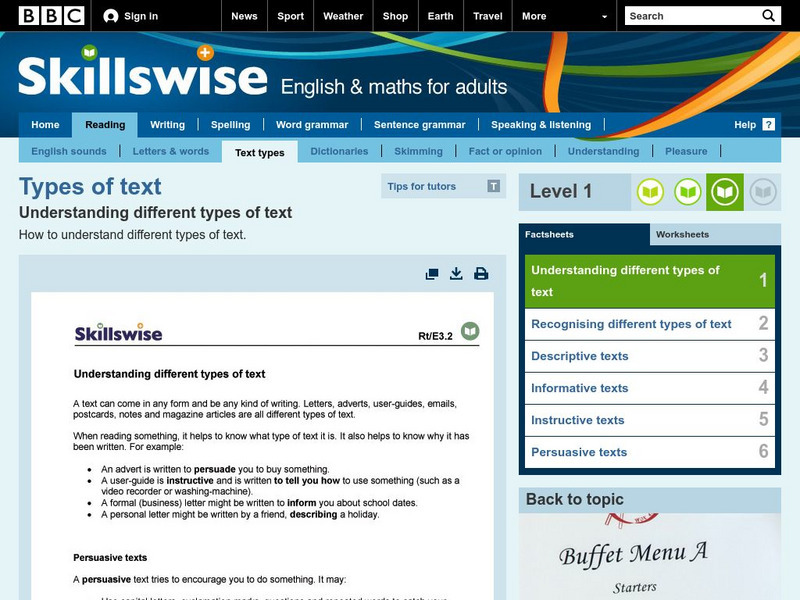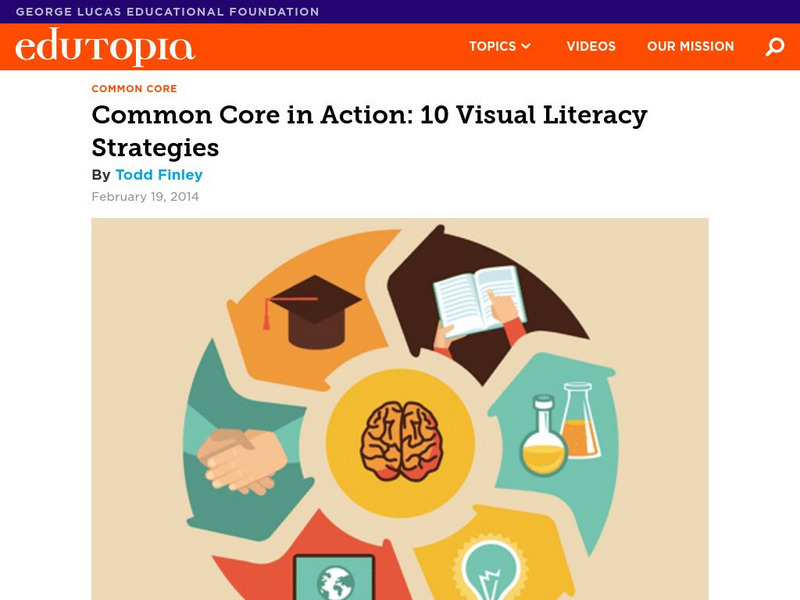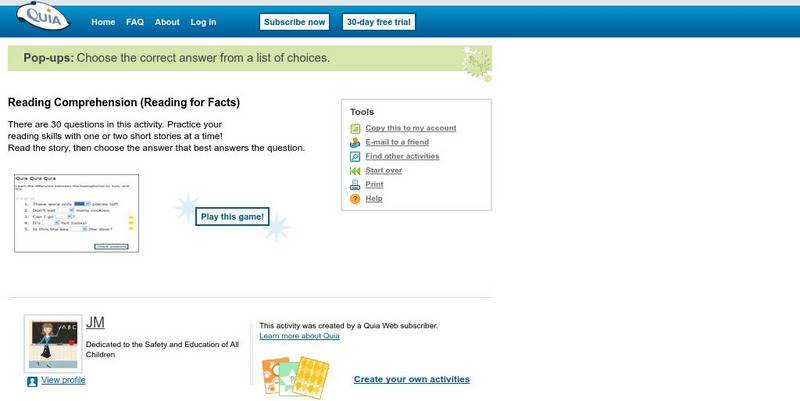E Reading Worksheets
E Reading Worksheets: Implicit Character Traits Worksheet
In this learning module, students will practice making inferences about character traits. A worksheet is provided to practice with finding implicit character traits. This module is designed to support Tier I, Tier II, and Tier III students.
TES Global
Tes: Guided Reading Resources: Nonfiction
[Free Registration/Login Required] This learning module contains several guided reading resources. Students will be able to use the charts to guide themselves as they discuss informational texts and persuasive texts. Teachers can monitor...
Sophia Learning
Sophia: Reading Strategies: Tutorial
In this slideshow tutorial, students will review different types of reading strategies to promote comprehension of text. The strategies included are the following: making predictions, visualizing, questioning the text, retelling,...
Sophia Learning
Sophia: Supporting Details: Facts and Statistics
This lesson discusses how statistics can be used as supporting details. This tutorial shares a short audio lesson [05:16] and supplemental notes with the lesson's content.
E Reading Worksheets
E Reading Worksheets: Making Predictions Worksheets and Lessons
In this learning module, students will learn more about making predictions in reading. Worksheets and a leson are provided to support Tier I, Tier II, and Tier III students.
ReadWriteThink
Read Write Think: Compare/contrast Electronic Text With Traditionally Printed Text
Lesson allows for middle school students who are familiar with researching electronic sources to gain a deeper understanding of the benefits of online resources versus traditional print.
Scholastic
Scholastic: Informational Text: Reading Response: Claim Evldence Reasoning [Pdf]
This graphic organizer can be used with students when they read informational text. Students will identify a claim, list text evidence that supports the claim, and explain how the information can be used for their future understanding of...
Polk Brothers Foundation Center for Urban Education at DePaul University
Depaul University: Center for Urban Education: Inference Organizer [Pdf]
Students will use a graphic organizer to help them make inferences. Students will list the literal text evidence and make an educated guess based on the text evidence.
Polk Brothers Foundation Center for Urban Education at DePaul University
Depaul University: Center for Urban Education: I Can Explain an Inference [Pdf]
This tool can be used to help students articulate their answers about fiction pieces. Students will quote the text, provide an inference, and give a justification.
Curated OER
Mc Graw Hill: 6th Grade Use Text Evidence
Learn how to use text evidence to draw inferences; click the Model button on bottom right.
E Reading Worksheets
E Reading Worksheets: Inferences Worksheets
In this learning module, students will learn more about making inferences. Worksheets are provided to reinforce the skill of making inferences. This module is designed to support Tier I, Tier II, and Tier III students.
CommonLit
Common Lit: Ataka
CommonLit.org is a wonderful resource to use in a Language Arts classroom. Each story or article is accompanied by guided reading questions, assessment questions, and discussion questions. In addition, students can click on words to see...
Learning Farm
Learning Farm: Word Relationships
Learn how word relationships affect the meaning of text, and then practice this skill.
International Literacy Association
Ila: Unlocking the Power of Informational Text With Five Creative Ideas
Five easy ways to help unlock the power of informational text for all students.
BBC
Bbc: Skillswise: Types of Texts Fact Sheets
Six printable fact sheets on how to understand and recognize different types of text including descriptive, informative, instructive, and persuasive.
University of Victoria (Canada)
Study Zone: From Carrots to Renovations: Reading Comprehension
A reading passage with five multiple-choice questions to assess comprehension.
CPALMS
Cpalms: "The Last Leaf": Making Inferences
This learning module has a series of screencast videos and practice exercises designed to teach students how to make inferences based on explicit and implicit information found within a text.
Edutopia
Edutopia: Common Core in Action: 10 Visual Literacy Strategies
Explicitly teach a collection of competencies that will help students think through, think about, and think with pictures.
Louisiana Department of Education
Louisiana Doe: Louisiana Believes: Ela Guidebooks: Accountable Talk
This strategy helps students refine their understanding of texts to meet reading expectations, engage in group conversations to meet speaking and listening expectations, and prepare for writing about texts.
AdLit
Ad lit.org: Classroom Strategies: Question the Author (Qt A)
Question the Author (QtA) is a comprehension strategy that requires students to pose queries while reading the text in order to challenge their understanding and solidify their knowledge (Beck et al., 1997).
E Reading Worksheets
E Reading Worksheets: Text Structure: Test 3
In this text structure test, students read passages and select the correct text structure; they are sometimes asked to explain how the evidence to prove their selections.
E Reading Worksheets
E Reading Worksheets: Text Structure: Reading Test 4
In this text structure reading test, students read passages and select the pattern of organization used; they sometimes have to explain their reasons using evidence from the text.
Quia
Quia: Rags to Riches: Context Clues
In this game, students use context clues in the passage to determine the meaning of vocabulary words.
Quia
Quia: Reading for Facts
This interactive quiz assesses students' reading comprehension skills of informational text passages. Students will read 30 short passages and answer question about a detail for each.







![Scholastic: Informational Text: Reading Response: Claim Evldence Reasoning [Pdf] Graphic Scholastic: Informational Text: Reading Response: Claim Evldence Reasoning [Pdf] Graphic](https://content.lessonplanet.com/knovation/original/244734-74184753ee53d6872b10ba36f1639585.jpg?1661510818)






